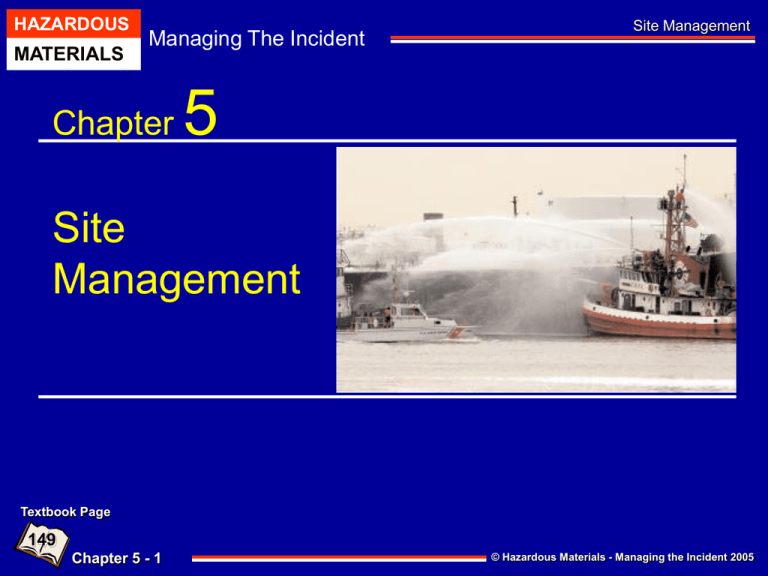Chapter 5 Site Management
advertisement

HAZARDOUS MATERIALS Managing The Incident Chapter Site Management 5 Site Management Textbook Page 149 Chapter 5 - 1 © Hazardous Materials - Managing the Incident 2005 HAZARDOUS MATERIALS Managing The Incident Site Management Objectives • • • • Define Site Management And Control. List And Describe The Six Major Tasks That Must Be Implemented As Past Of The Site Management And Control Process. Describe The Procedures For Initially Establishing Command At A Hazmat Incident.’ Describe The Guidelines For The Safe Approach And Positioning Of Emergency Response Personnel At A Hazmat Incident. Chapter 5 - 2 © Hazardous Materials - Managing the Incident 2005 HAZARDOUS MATERIALS Managing The Incident Site Management Objectives • Define The Following Terms And Describe Their Significance In Controlling Emergency Response Resources At A Hazmat Incident: Staging • • • • Level 1 Staging Level 2 Staging Describe The Procedures For Establishing Scene Control Through The Use Of An Isolation Perimeter At A Hazmat Incident. Chapter 5 - 3 © Hazardous Materials - Managing the Incident 2005 HAZARDOUS MATERIALS Site Management Managing The Incident Objectives • Describe The Procedures For Establishing Scene Control Through The Use Of Hazard Control Zones At A Hazmat Incident. Define The Following Terms And Describe Their Significance In Establishing Hazard Control Zones: • • • • • • Hazard Control Zones [NFPA 472 - 3.3.13] Hot Zone [NFPA -472 - 3.3.13.2] Warm Zone [NFPA 472- 3.3.13.3] Cold Zone [NFPA 472 - 3.3.13.1] Area Of Refuge Chapter 5 - 4 © Hazardous Materials - Managing the Incident 2005 HAZARDOUS MATERIALS Managing The Incident Site Management Objectives • Describe The Role Of On-scene Security And Law Enforcement Personnel In Establishing Perimeters At A Hazmat Emergency. [NFPA 472 – 7.3.4.3 (6)] • Define The Following Terms And Describe Their Significance In Protecting The Public At A Hazmat Incident: • Public Protective Actions • Protection-in-place • Evacuation Chapter 5 - 5 © Hazardous Materials - Managing the Incident 2005 HAZARDOUS MATERIALS Managing The Incident Site Management Objectives • Describe Three Criteria For Evaluating Protectionin-place As A Public Protective Action Option. [NFPA 472 – 7.3.4.3 (1 Through 12] • Describe The Guidelines And Procedures For Implementing Protection-in-place At A Hazmat Incident. • Describe Three Criteria For Evaluating Evacuation As A Public Protective Action Option. Chapter 5 - 6 © Hazardous Materials - Managing the Incident 2005 HAZARDOUS MATERIALS Managing The Incident Site Management Objectives • List The Four Criteria For Implementing A Limited Scale Evacuation. • Define Sick Building Syndrome And List Three Indicators Of A Sick Building. • List Four Situations That May Justify A Full Scale Evacuation. • List Four Critical Issues That Must Be Addressed By The Incident Commander To Effectively Manage A Full Scale Evacuation. Chapter 5 - 7 © Hazardous Materials - Managing the Incident 2005 HAZARDOUS MATERIALS Site Management Managing The Incident Introduction • Site Management Is The First Step In The Eight Step Incident Management Process©. • The Major Emphasis Of Site Management Is On Establishing Control Of The Incident Scene • Site Management And Control Provide The Foundation For The Response • The Actions Taken By The Incident Commander (IC) In The First Ten Minutes Of The Incident Usually Dictates How The Next Hour Will Go. Chapter 5 - 8 © Hazardous Materials - Managing the Incident 2005 HAZARDOUS MATERIALS Managing The Incident Site Management Terminology And Definitions • Staging –The Safe Area Established For Temporary Location Of Available Resources Closer To The Incident Site To Reduce Response Time. • Level I Staging - The Initial Location For Emergency Response Units At A Multiple Unit Response To A Hazmat Incident. • Level II Staging – The Location Where Arriving Units Are Initially Sent When An Incident Escalates Past The Capability Of The Initial Response. Chapter 5 - 9 © Hazardous Materials - Managing the Incident 2005 HAZARDOUS MATERIALS Managing The Incident Site Management Terminology And Definitions • Isolation Perimeter —the Designated Crowd Control Line Surrounding The Hazard Control Zones. • Hazard Control Zones — Designation Of Areas At A Hazardous Materials Incident Based Upon Safety And The Degree Of Hazard. • Hot Zone – The Control Zone Immediately Surrounding A Hazardous Materials Incident Which Extends Far Enough To Prevent Adverse Effects From Hazardous Materials Releases To Personnel Outside The Zone. • Warm Zone – The Control Zone At A Hazardous Materials Incident Site Where Personnel And Equipment Decontamination And Hot Zone Support Takes Place. Chapter 5 - 10 © Hazardous Materials - Managing the Incident 2005 HAZARDOUS MATERIALS Managing The Incident Site Management Terminology And Definitions • Cold Zone – The Areas At A Hazardous Materials Incident That Contains The Command Post And Other Support Functions Necessary To Control The Incident. • Area Of Refuge — A "Holding Area" Within The Hot Zone Where Personnel Are Controlled Until They Can Be Safely Decontaminated Or Treated. • Public Protective Actions (PPA) - The Strategy Used By The Incident Commander To Protect The General Population From The Hazardous Material By Implementing A Strategy Of Either Chapter 5 - 11 © Hazardous Materials - Managing the Incident 2005 HAZARDOUS MATERIALS Managing The Incident Site Management Terminology And Definitions • Protection In-place (A.K.A. Shelter-in-place) Directing People To Go Inside A Building, Seal It Up As Effectively As Possible, And Remain There Until The Danger From A Hazardous Materials Release Has Passed. • Evacuation — the Controlled Relocation Of People From An Area Of Known Danger Or Unacceptable Risk To A Safer Area, Or One In Which The Risk Is Considered To Be Acceptable. Chapter 5 - 12 © Hazardous Materials - Managing the Incident 2005 HAZARDOUS MATERIALS Managing The Incident Site Management Site Management Tasks • From A Tactical Perspective, Site Management Can Be Divided Into Six Major Tasks. These Include: • Assuming Command And Establishing Control Of The Incident Scene. • Assuring Safe Approach And Positioning Of Emergency Response Resources At The Incident Scene. • Establishing Staging As A Method Of Controlling Arriving Resources. • Establishing An Isolation Perimeter Around The Incident Scene. 152 Chapter 5 - 13 © Hazardous Materials - Managing the Incident 2005 HAZARDOUS MATERIALS Managing The Incident Site Management Site Management Tasks • Establishing Hazard Control Zones To Assure A Safe Work Area For Emergency Responders And Supporting Resources. • Sizing Up The Need For Immediate Rescue And Implementing Initial Public Protective Actions. • Life Safety Is The Highest Tactical Priority Of Any Incident Commander. • Even Under The Most Extreme Situations, Implementing Initial Site Management Tasks Will Save Lives. Chapter 5 - 14 © Hazardous Materials - Managing the Incident 2005 HAZARDOUS MATERIALS Site Management Managing The Incident Establishing Command • Hazmat Incidents Require Strong, Centralized Command. • The Success Or Failure Of Emergency Operations Will Depend On The Manner In Which The Firstarriving Officer Or Responder Establishes Command. • • • • • Correctly Assume Command. Confirm Command. Select A Stationary Location For The Command Post. Establish A Staging Area. Request Necessary Assistance. Chapter 5 - 15 © Hazardous Materials - Managing the Incident 2005 HAZARDOUS MATERIALS Managing The Incident Site Management Approach And Positioning • Safe Approach And Positioning By The Initial Emergency Responders Is Critical To How The Overall Incident Will Be Managed • Some General Guidelines Include: • Approach From Uphill And Upwind • Look For Physical Hazmat Clues • Conditions Can Change Quickly At Hazmat Incidents Chapter 5 - 16 © Hazardous Materials - Managing the Incident 2005 HAZARDOUS MATERIALS Site Management Managing The Incident Staging Areas • Staging Procedures Facilitate Safety And Accountability By Allowing For The Orderly, Systematic And Deliberate Deployment Of Responders. • Staging Becomes An Element Within The Operations Section • The Ideal Staging Area Is Close Enough To The Isolation Perimeter To Significantly Reduce Response Time, Yet Far Enough Away To Allow Units To Remain Highly Mobile For Assignment. Chapter 5 - 17 © Hazardous Materials - Managing the Incident 2005 HAZARDOUS MATERIALS Managing The Incident Site Management Staging Areas • Level I Staging • Level I Staging Should Be Used For Any Multiple Unit Response To A Hazmat Incident. • Normally, Level I Staging Takes Place When Units Stop Short Of The Scene (Approximately One Block In Their Direction Of Travel), Or Remain Outside Of A Facility’s Main Gate. Level I Staging Should Be In A Safer Upwind Location. Obviously, You Should Not Drive Through An Unsafe Location Just To Take Up A Position In A Safer Location. Chapter 5 - 18 © Hazardous Materials - Managing the Incident 2005 HAZARDOUS MATERIALS Managing The Incident Site Management Staging Areas • Level II Staging • Level II Staging- Is Used When An Incident Escalates Past The Capability Of The Initial Response. Level II Staging Is A Management Tool Usually Reserved For Large, Complex, Or Lengthy Hazmat Operations. • Staging Areas Should Be Clearly Identified Through The Use Of Signs, Color-coded Flags Or Lights, Or Other Suitable Means. Chapter 5 - 19 © Hazardous Materials - Managing the Incident 2005 HAZARDOUS MATERIALS Managing The Incident Site Management Isolation Perimeter The Isolation Perimeter Is The Designated Crowd Control Line Surrounding The Incident Scene That Is Set Up To Maintain The Safety And Security Chapter 5 - 20 © Hazardous Materials - Managing the Incident 2005 HAZARDOUS MATERIALS Managing The Incident Site Management Isolation Perimeter • The Isolation Perimeter Separates The “Players” From The “Spectators” • Spectators = The General Public • Players = Emergency Responders And Other Support Personnel Who Are Part Of The Team • The Isolation Perimeter Should Be Flexible • Big Hazards And Risks = Big Isolation Perimeter 155 Chapter 5 - 21 © Hazardous Materials - Managing the Incident 2005 HAZARDOUS MATERIALS Site Management Managing The Incident Isolation Perimeter for Highways CONTROL area close to spill CONTROL points between CONTROL area intersections away from spill Chapter 5 - 22 © Hazardous Materials - Managing the Incident 2005 HAZARDOUS MATERIALS Site Management Managing The Incident Hazard Control Zones ISOLATION PERIMETER ICP HOT ZONE WARM ZONE ENTRY DECON CORRIDOR COLD ZONE Chapter 5 - 23 © Hazardous Materials - Managing the Incident 2005 HAZARDOUS MATERIALS Site Management Managing The Incident Establishing Hazard Control Zones • The Primary Purpose Of Establishing Three Different Hazard Control Zones Is To Provide The Highest Possible Level Of Control And Personnel Accountability • As A General Rule, The Public Should Always Be Located Outside Of The Isolation Perimeter. Chapter 5 - 24 Isolation perimeter Hot Warm Cold © Hazardous Materials - Managing the Incident 2005 HAZARDOUS MATERIALS Site Management Managing The Incident Defining Hazard Control Zones First Law Of Hot Zone Operations Trained To Play Dressed To Play Buddy System With A Back-up Capability DECON Established Coordination With The IC And Safety Officer An Area Of Refuge (Safe Refuge Area) Within The Hot Zone Chapter 5 - 25 Isolation perimeter Hot Warm Cold © Hazardous Materials - Managing the Incident 2005 HAZARDOUS MATERIALS Site Management Managing The Incident Identifying Hazard Control Zones • Hazard Control Zones Should Be Clearly Marked And Posted On The IC's Tactical Command Worksheet. • Outdoor Situations Hazard Control Zones Can Be Designated By Using Key Geographical Reference Points Such As A Tank Dike Wall, Fence line, Or Street Name. • When The Hazard Is Inside Of A Building, These Zones Can Be Denoted By Their Location Within The Structure. • The IC Should Move Toward A More Definitive Assessment Using Monitoring Instruments. Chapter 5 - 26 © Hazardous Materials - Managing the Incident 2005 HAZARDOUS MATERIALS Site Management Managing The Incident Identifying Hazard Control Zones • Initial Monitoring Efforts Should Concentrate On Determining If IDLH Concentrations Are Present. • Decisions Regarding The Size Of Hazard Control Zones Should Be Based On The Following: • Flammability —the IDLH Action Level Is 10% Of The Lower Explosive Limit (LEL). Any Areas Above This Concentration Are Clearly Inside The Hot Zone. • Oxygen — an IDLH Oxygen-deficient Atmosphere Is 19.5% Oxygen Or Lower, While An Oxygen-enriched Atmosphere Contains 23.5% Oxygen Or Higher. Chapter 5 - 27 © Hazardous Materials - Managing the Incident 2005 HAZARDOUS MATERIALS Site Management Managing The Incident Identifying Hazard Control Zones • Toxicity — unless A Published Action Level Or Similar Guideline Is Available (ERPG-2), The STEL Or IDLH Values Should Initially Be Used. • Hot Zone—monitoring Readings Above STEL Or IDLH Exposure Values. • Warm Zone—monitoring Readings Equal To Or Greater Than TLV/TWA Or PEL Exposure Values. • Cold Zone—monitoring Readings Less Than TLV/TWA Or PEL Exposure Values. Chapter 5 - 28 © Hazardous Materials - Managing the Incident 2005 HAZARDOUS MATERIALS Site Management Managing The Incident Identifying Hazard Control Zones • Radioactivity — any Positive Reading Two Twice Above Background Levels Or Alpha And/Or Beta Particles That Are 200 To 300 Counts Per Minute (CPM) Above Background Would Confirm The Existence Of A Radiation Hazard And Should Be Used As The Basis For Establishing A Hot Zone. Chapter 5 - 29 © Hazardous Materials - Managing the Incident 2005 HAZARDOUS MATERIALS Site Management Managing The Incident Identifying Hazard Control Zones • Safe Operating Procedures Should Strictly Control And Limit The Number Of Personnel Working In The Hot Zone. • Most Hazmat Operations Can Be Accomplished With Two To Four Personnel Working For Specified Time Periods Using The Buddy System. Chapter 5 - 30 © Hazardous Materials - Managing the Incident 2005 HAZARDOUS MATERIALS Site Management Managing The Incident Identifying Hazard Control Zones • The Size Of Hazard Control Zones Should Change Over Time As The Risks Increase Or Decrease. • Don’t Keep The Property Owner Or Law Enforcement Personnel Out Of The Information Loop. • While A Large Perimeter Surrounding The Incident Is Desirable, A Common Mistake Is To Seal Off More Real Estate Than Can Be Effectively Controlled. Chapter 5 - 31 © Hazardous Materials - Managing the Incident 2005 HAZARDOUS MATERIALS Site Management Managing The Incident Roles Of Law Enforcement Personnel • Law Enforcement Officers Should Be Briefed With All Available Information. • The People Who Are Actually Involved In Establishing A Perimeter Need To Know Exactly What The Potential Hazards And Risks Appear To Be. • Law Enforcement Personnel Are Best Utilized Where Traffic And Crowd Control Will Involve Large Groups Of People. Chapter 5 - 32 © Hazardous Materials - Managing the Incident 2005 HAZARDOUS MATERIALS Site Management Managing The Incident Rescue And Public Protective Actions • Scenarios May Occur Where Immediate Response Actions Are Required In Order To Rescue Or Remove Victims From A Hazardous Environment. • Most Tactical Hazmat Response Operations Are Not Well-suited For Rapid Entry And Extrication Operations. • Public Protective Actions (PPA) Are The Strategies To Protect The General Population From The Hazardous Material. • Protecting-in-place • Evacuation • A Combination Of Both Strategies 161 Chapter 5 - 33 © Hazardous Materials - Managing the Incident 2005 HAZARDOUS MATERIALS Site Management Managing The Incident Initiating Public Protective Actions • PPA Strategies Are Usually Implemented After The IC Has Established An Isolation Perimeter And Defined The Hazard Control Zones For Emergency Responders. • There Are No Clear Benchmarks For The PPA Decision-making Process. • One Common Misunderstanding About PPA Strategies Is That The IC Must Use One Strategy Versus The Other. This Is NOT An Either–or Choice. Chapter 5 - 34 © Hazardous Materials - Managing the Incident 2005 HAZARDOUS MATERIALS Site Management Managing The Incident Initial PPA Decision-Making • PPA Decisions Are Very IncidentSpecific And Require The Use Of The IC's Judgment And Experience. • The IC’s Decision To Either Evacuate Or Protect-in-place Should Be Based Upon The Following Factors: • • • • Hazardous Material(s) Involved The Population At Risk The Time Factors Involved In The Release. The Effects Of The Present And Projected Meteorological Conditions Upon The Control And Movement Of The Hazardous Materials Chapter 5 - 35 © Hazardous Materials - Managing the Incident 2005 HAZARDOUS MATERIALS Managing The Incident Site Management Initial PPA Decision-Making • The Capability To Communicate With The Population At Risk And Emergency Response Personnel Prior To, During, And After The Emergency • The Availability And Capabilities Of Hazmat Responders and Other Personnel To Implement, Control, Monitor, And Terminate The Protective Action. • Incident Commander Use A Systematic And Structured Approach To Clearing The Public Away From The Hazard Area. • Be Aware That If The Situation Deteriorates Rapidly, Exposures Within 1,000 Feet May Be Contaminated. Chapter 5 - 36 © Hazardous Materials - Managing the Incident 2005 HAZARDOUS MATERIALS Managing The Incident Site Management Initial PPA Decision-Making • Areas Which Should Receive Immediate Attention By The IC Include: • Locations Within 1,000 Feet Of The Incident Which Will Be Rapidly Overtaken By The Hazmat. • Locations Near The Incident Where People Are Already Reasonably Safe From The Hazmat. • Key Locations That Control The Flow Of Traffic And Pedestrians Into The Hazard Area. • Special High-occupancy Structures Such As Schools. • Structures Containing Sick, Disabled, Or Incarcerated Persons. Chapter 5 - 37 © Hazardous Materials - Managing the Incident 2005 HAZARDOUS MATERIALS Managing The Incident Site Management Protection-in-Place • The Protection In-Place Strategy Involves Directing People To Go Inside Of A Building, Seal It Up As Effectively As Possible, And Remain There Until The Danger From A Hazardous Materials Release Has Passed. Protection-in-place (A.K.A. – Sheltering In Place). • In Its June, 2001 Report Entitled “Sheltering In Place As A Public Protective Action,” NICS Reviewed A Number Of Case Studies To Determine Whether It Is Better To Evacuate Or Protect-inplace During A Chemical Release. Chapter 5 - 38 © Hazardous Materials - Managing the Incident 2005 HAZARDOUS MATERIALS Managing The Incident Site Management Protection-in-Place • The Report Concluded As Follows: • Sheltering-in-place Is An Appropriate Public Protection Tool In The Right Circumstances. • For All Case Studies Examined During This Study, There Were No Fatalities Associated With Sheltering In Place. • The Body Of Evidence Suggests That If There Is Insufficient Time To Complete An Evacuation, Or The Chemical Leak Will Be Of Limited Duration, Or Conditions Would Make An Evacuation More Risky Than Staying In Place, Then Sheltering In Place Is A Good Way To Protect The Public During Chemical Emergencies. Chapter 5 - 39 © Hazardous Materials - Managing the Incident 2005 HAZARDOUS MATERIALS Managing The Incident Site Management Protection-in-Place • Research And Accident Investigations Clearly Indicate That Staying Indoors May Provide A Safe Haven During Toxic Vapor Releases. • The Incident Commander May Have To Make Critical Decisions Based Upon Weather Conditions And Forecasts. Chapter 5 - 40 © Hazardous Materials - Managing the Incident 2005 HAZARDOUS MATERIALS Managing The Incident Site Management Protection-in-Place • The Best Option For The Following Types Of Situations: • The Hazardous Material Have Been Totally Released From Its Container And Is Dissipating. • The Released Material Forms A “Puff” Or Migrating Plume Pattern. • A Fast-moving Toxic Vapor Cloud Will Quickly Overrun Exposed People. 167 Chapter 5 - 41 © Hazardous Materials - Managing the Incident 2005 HAZARDOUS MATERIALS Managing The Incident Site Management Protection-in-Place • The Best Option For The Following Types Of Situations: • Short-duration Solid Or Liquid Leaks Are Present. • Leaks That Can Be Rapidly Controlled At Their Source By Engineered Suppression Or Mitigation Systems, Or Through ERP Containment And Confinement Tactics. Chapter 5 - 42 © Hazardous Materials - Managing the Incident 2005 HAZARDOUS MATERIALS Managing The Incident Site Management Protection-in-Place • When Protection-in-place Is The Best Course Of Action, The IC Must Make Sure That The Public Is Provided With Clear Instructions On What They Should Do. • The Following Are Examples: • Close All Doors To The Outside And Close And Lock All Windows. Seal Any Obvious Gaps Around Windows, Doors, Vents • Turn Off All Heating Ventilating, And Air Conditioning Systems (HVAC) Systems And Air Window Unit Air Conditioners. • Close Fireplace Dampers. If There Is A Fire In The Fireplace, Let It Burn Down Without Closing The Dampers! • Turn Off And Cover All Exhaust Fans. • Close As Many Internal Doors As Possible. Chapter 5 - 43 © Hazardous Materials - Managing the Incident 2005 HAZARDOUS MATERIALS Site Management Managing The Incident Protection-in-Place • Pick One Room In The House Or Structure To Use As A Shelter Room. • Monitor The Local Am/Fm Radio Or Local Television Stations For Further Information. • Experience Has Shown That The Public’s Compliance With The IC’s Recommendations And Instructions Will Be Dependent Upon The Following Factors: • Receipt Of A Timely And An Effective Warning Message. • Clear Rationale For The Decision To Protect-in-place, As Compared To An Evacuation. • Credibility Of Emergency Response Personnel • Previous Training And Education Chapter 5 - 44 © Hazardous Materials - Managing the Incident 2005 HAZARDOUS MATERIALS Site Management Managing The Incident Evaluating Structures For Protection-in-Place • Hazmat Responders Should Be Familiar With The Types Of Structures Within The Community And Consider The Following Variables: • Age Of The Building—older Buildings Do Not Seal Well. • Prevailing Wind Direction – Most Communities Have A Predictable Prevailing Wind Direction That Is Seasonal. • Building Height — The Geometry Of Highrise Buildings And Their Proximity To One Another Significantly Effects The Movement Of Toxic Gas. Chapter 5 - 45 © Hazardous Materials - Managing the Incident 2005 HAZARDOUS MATERIALS Managing The Incident Site Management Los Alamos National Laboratory Research “For An Outdoor Plume Release, Closing The Windows And Doors And Staying Inside May Be Initially Safer Than Remaining Indoors. • Due To Infiltration (E.G., Leaks, Ventilation) And The Eventual Passage Of The Bulk Of The Plume, There May Come A Time When It Is Actually Safer To Be Outdoors Rather Than Indoors. • Chapter 5 - 46 © Hazardous Materials - Managing the Incident 2005 HAZARDOUS MATERIALS Managing The Incident Site Management Los Alamos National Laboratory Research Emergency Response Decision Makers Responsible For Public Announcements Should Be Aware That Safe Zones May Change From Inside To Outside Buildings During The Course Of The Event, So That Strict Guidelines For When To Go Outside May Be Difficult To Derive.” Chapter 5 - 47 © Hazardous Materials - Managing the Incident 2005 HAZARDOUS MATERIALS Managing The Incident Site Management Los Alamos National Laboratory Research • Neighborhood Surveys • Neighborhood Surveys Can Reveal A Significant Amount Of Information Concerning The Types Of Buildings Present And They Can Influence Organizational Policy Concerning Whether Protection-in-place Is A Viable Option. • Some Jurisdictions And Petrochemical Companies Have Adopted A Simple Survey Tool To Evaluate The Various Types Of Structures. Chapter 5 - 48 © Hazardous Materials - Managing the Incident 2005 HAZARDOUS MATERIALS Site Management Managing The Incident Los Alamos National Laboratory Research • The Following Rating System For Protection-inplace Provides Some General Guidelines For Evaluating Structures: • • • • Type I Structure Type II Structure Type III Structure Type IV Structure 169 Chapter 5 - 49 © Hazardous Materials - Managing the Incident 2005 HAZARDOUS MATERIALS Site Management Managing The Incident Rating System For Protect-in-Place • Type I Structure Modern, Energy Efficient Building Constructed Since 1970. Or, Older Building With Upgraded Energy Efficiency Chapter 5 - 50 © Hazardous Materials - Managing the Incident 2005 HAZARDOUS MATERIALS Site Management Managing The Incident Rating System For Protect-in-Place • Type II Structure Older Construction, With Limited Energy Efficiency. Constructed Between 1950 And 1970. Chapter 5 - 51 © Hazardous Materials - Managing the Incident 2005 HAZARDOUS MATERIALS Site Management Managing The Incident Rating System For Protect-in-Place • Type III Structure Oldest Type Construction Built Before1950 Chapter 5 - 52 © Hazardous Materials - Managing the Incident 2005 HAZARDOUS MATERIALS Managing The Incident Site Management Los Alamos National Laboratory Research • Type IV Structure Mobil Home, Trailer, Shed, Etc. Without Energy Efficiency. Chapter 5 - 53 © Hazardous Materials - Managing the Incident 2005 HAZARDOUS MATERIALS Managing The Incident Site Management Evacuation • Evacuation Is The Controlled Relocation Of People From An Area Of Known Danger Or Unacceptable Risk To A Safer Area, Or One In Which The Risk Is Considered To Be Acceptable. • Evacuation Of Both Industrial Fixed Facility Personnel And The General Public Is An Attempt To Avoid Their Exposure To Any Quantity Of The Released Hazardous Material. • For Our Purposes, We Will Describe Evacuations In Terms Of Limited-scale And Full-scale Evacuations. 172 Chapter 5 - 54 © Hazardous Materials - Managing the Incident 2005 HAZARDOUS MATERIALS Site Management Managing The Incident Limited Scale Evacuations • Limited Scale Evacuations Are Implemented By The IC When The Incident Effects One Or Two Buildings In The Vicinity Of The Incident. • The U.S. Department Of Health And Human Services, Agency For Toxic Substances Disease Registry, Conducts A Biennial Study • The Study Found There Were 13,808 Hazardous Substances Emergency Events Reported That Produced 4,425 Injuries And 74 Fatalities. Chapter 5 - 55 © Hazardous Materials - Managing the Incident 2005 HAZARDOUS MATERIALS Site Management Managing The Incident Limited Scale Evacuations • The Study Showed That 73% Of These Events Occurred At Fixed Facilities And The Remainder Involved Transportation Incidents. • In The 13,808 Incidents Discussed Above, Evacuations Were Ordered In 1,182 Events. • The Median Number Of People Evacuated In These Events Was Just 20 People • Interestingly, A Contingency Plan Was Followed By The Incident Commander In 95% Of The Events. Chapter 5 - 56 © Hazardous Materials - Managing the Incident 2005 HAZARDOUS MATERIALS Site Management Managing The Incident Limited Scale Evacuations • A Limited Scale Evacuation May Be The Best Option For The IC Under The Following Conditions: • Whenever The Building Is On Fire. • Whenever The Hazmat Is Leaking Inside The Building And The Material Is Flammable Or Toxic. • Whenever Explosives Or Reactive Materials Are Involved And Can Detonate Or Explode, Producing Flying Glass Or Structural Collapse. • Whenever The Building Occupants Show Signs Or Symptoms Of Acute Illness And There Is A Known Hazmat Spill Inside The Structure. Chapter 5 - 57 © Hazardous Materials - Managing the Incident 2005 HAZARDOUS MATERIALS Managing The Incident Site Management Sick Building Syndrome • SBS Is A Situation In Which Occupants Of A Building Experience Acute Health Effects That Seem To Be Linked To Time Spent In A Building, But No Specific Illness Or Cause Can Be Identified. Indicators Of Sick Buildings Include: • Building Occupants Complain Of Symptoms Associated With Acute Discomfort, E.G., Headache; Eye, Nose, Or Throat Irritation; Dry Cough; Dry Or Itchy Skin; Dizziness And Nausea; Difficulty In Concentrating; Fatigue; And Sensitivity To Odors. • The Cause Of The Symptoms Is Not Known. • Most Of The Complainants Report Relief Soon After Leaving The Building. Chapter 5 - 58 © Hazardous Materials - Managing the Incident 2005 HAZARDOUS MATERIALS Site Management Managing The Incident Evacuation Of Fixed Industrial Facilities • Unlike Their Public Safety Counterparts, Industrial Emergency Response Teams Have The Advantage Of Knowing Exactly What Types Of Hazardous Materials Are In Their Facilities. • OSHA Requires Fixed Facilities To Have Written Evacuation Procedures. Wellwritten PPA Procedures Can Provide Useful Guidelines To Supervisors And The Facility IC Concerning Whether A Limited- Or Full-scale Evacuation Is Necessary. Chapter 5 - 59 © Hazardous Materials - Managing the Incident 2005 HAZARDOUS MATERIALS Managing The Incident Site Management Levels Of Protective Actions • Level One Incident Protective Action - A Level One Protective Action Requires All Employees And Contractors To Evacuate The Work Site • Level Two Incident Protective Action - A Level Two Incident Will Require Personnel To Evacuate The Immediate Work Site And Meet At The Predesignated Assembly Area For Accountability • Level Three Incident Protective Action - A Level Three Incident Is A Major Emergency Which Requires The Total Evacuation Of All Company Personnel And The Surrounding Public Chapter 5 - 60 © Hazardous Materials - Managing the Incident 2005 HAZARDOUS MATERIALS Managing The Incident Site Management Full Scale Evacuations • Full Scale Evacuations Involve The Relocation Of Large Populations From A Hazardous Area To A Safe Area. • Life Safety - In Some Cases, Evacuations May Endanger The Lives Of The People Being Evacuated. Chapter 5 - 61 © Hazardous Materials - Managing the Incident 2005 HAZARDOUS MATERIALS Managing The Incident Site Management Full Scale Evacuations • Expense - Full-scale Evacuations Are Expensive. Costs To The Public Sector Are Approximately Three Times As High And Fifteen Times As High For The Manufacturing Sector. • Fortunately, Most Incident Commanders Will Never Be Faced With The Decision To Evacuate Thousands Of People, But That Should Not Be An Excuse For Being Unprepared. Chapter 5 - 62 © Hazardous Materials - Managing the Incident 2005 HAZARDOUS MATERIALS Managing The Incident Site Management Full Scale Evacuations • The World Trade Center – The Terrorist Attacks Of September 11, 2001 And The Subsequent Collapse Of The New York City’s World Trade Center Towers Was The Worst Building Disaster In Recorded History, Killing Some 2,800 People. More Than 350 Emergency Response Personnel Died In The Line Of Duty And Are Credited With Saving Approximately 25,000 Lives Through Their Extreme Heroism When They Directly Supervised The Evacuation Of The Buildings Occupants. It Is Estimated That Between 300,000 And 1 Million People Evacuated Manhattan Island By Powerboat, Ferry, Barge, Or Tugboat. Chapter 5 - 63 © Hazardous Materials - Managing the Incident 2005 HAZARDOUS MATERIALS Managing The Incident Site Management Full Scale Evacuations • Mississauga, Ontario - On November 10, 1979 At 11:53 Pm, A Toronto-bound Canadian Pacific Train No. 54 Derailed At Mississauga, Ontario (A Suburb Of Toronto) Spilling Hazardous Materials. Police Evacuated 218,384 Residents From The Area Due To The Threat Presented By Chlorine Vapors. • Three Mile Island - On March 28, 1979 At 4:00 Am, A Malfunction In The Secondary Cooling Circuit At The Three Mile Island Nuclear Plant Near Harrisburg, PA And Initiated The Largest Nuclear Power Facility Accident In U.S. History. The Accident Led To 145,000 People Being Evacuated From An Area That Extended About 15 Miles From The Plant. Chapter 5 - 64 © Hazardous Materials - Managing the Incident 2005 HAZARDOUS MATERIALS Site Management Managing The Incident Full Scale Evacuations • The Decision To Commit Most Emergency Response Resources To A Full Scale Evacuation Should Be Initially Determined By The Incident Commander Based Upon The Specific Conditions Of The Emergency. • Some Situations That May Justify A Full-scale Evacuation Include: • Large Leaks Involving Flammable And/Or Toxic Gases From Large-capacity Storage Containers And Process Units. Chapter 5 - 65 © Hazardous Materials - Managing the Incident 2005 HAZARDOUS MATERIALS Managing The Incident Site Management Full Scale Evacuations • Large Quantities Of Materials Which Could Detonate Or Explode, Damaging Additional Process Units, Structures, And Storage Containers In The Immediate Area. • Leaks And Releases That Are Difficult To Control And Could Increase In Size Or Duration. • Whenever The Incident Commander Determines That The Release Cannot Be Controlled And Facility Personnel And/Or The General Public Are At Risk. Chapter 5 - 66 © Hazardous Materials - Managing the Incident 2005 HAZARDOUS MATERIALS Managing The Incident Site Management Full Scale Evacuations • When The Decision Is Made To Commit To A Fullscale Public Evacuation, Four Critical Issues Must Be Addressed And Managed Effectively In Order For The Operation To Succeed. • • • • Alerting And Notification Transportation Relocation Facility Information Chapter 5 - 67 © Hazardous Materials - Managing the Incident 2005 HAZARDOUS MATERIALS Managing The Incident Site Management Alerting And Notification • In Order For Evacuation To Be Successful, The IC Must Assure That People Are Quickly Alerted That There Is An Emergency In Progress. • The Location Of The General Population And The Time Of Day Should Always Be A Factor In The IC's Decision-making Process. • In Urban Areas, Up To 20% Of The Population Could Be In Transit To Or From Their Homes. • Rush-hour Traffic And The Time Of Day Are Significant Factors In Deciding Whether Or Not To Evacuate. Chapter 5 - 68 © Hazardous Materials - Managing the Incident 2005 HAZARDOUS MATERIALS Site Management Managing The Incident Population Locations Location / Activity Hours Per Day Percent of Time Home 16.6 69.2 School / Work 4.7 19.6 Commuting 1.2 5.0 Outdoors 1.5 6.2 181 Chapter 5 - 69 © Hazardous Materials - Managing the Incident 2005 HAZARDOUS MATERIALS Site Management Managing The Incident Alerting And Notification • A Brief Summary Of The Different Alerting Methods Is As Follows: • • • • • • • • • • • Door-to-door Loudspeakers/Public Address Systems Tone Alerted Radios Emergency Alerting System Scanner Radios And Weather Radios Commercial Television And Radio Sirens And Alarms Aircraft Electronic Billboards Computerized Telephone Notification System Low Power AM Radio Systems Chapter 5 - 70 © Hazardous Materials - Managing the Incident 2005 HAZARDOUS MATERIALS Site Management Managing The Incident Alerting Systems In Fixed Facilities • At A Fixed Facility Such As A Refinery Or Chemical Plant, The Notification Process Normally Occurs By Activation Of Sirens Or By Use Of An On-site Public Address System. • As A General Rule, Evacuation Alarms Should Be Unique And Distinctly Different From Any Other Type Of Alarm In The Facility. Chapter 5 - 71 © Hazardous Materials - Managing the Incident 2005 HAZARDOUS MATERIALS Site Management Managing The Incident Alerting Systems In Fixed Facilities • As Part Of The Pre-incident Planning Process, Fixed Facility Personnel Should Have Special Knowledge Of The Following: • Methods By Which Their Personnel Are Notified Of An Emergency Evacuation, Including Sound Of The Alarm System. • Instructions On Where Personnel Should Report To And Assemble When The Evacuation Alarm Is Sounded. • Facility Evacuation Routes And Corridors. • Safe Havens Where Personnel Can Seek Refuge If Evacuation Is Not Possible Or Advisable Chapter 5 - 72 © Hazardous Materials - Managing the Incident 2005 HAZARDOUS MATERIALS Site Management Managing The Incident Alerting Systems In Fixed Facilities • Ability To Communicate With Facility Personnel At Evacuation Assembly Areas. This Is Critical In Accounting For Evacuees And Initiating Search And Rescue Operations. • Location Of Both Primary And Alternate Assembly Locations. • Once Notified And Evacuated, A Head Count Should Be Taken Of Facility Personnel, Contractors, And Visitors To Ensure That All Personnel Are Accounted For. Chapter 5 - 73 © Hazardous Materials - Managing the Incident 2005 HAZARDOUS MATERIALS Managing The Incident Site Management Transportation • Experience In Large-scale Evacuations Indicates That The Majority Of The Affected Population Will Leave The Hazardous Area By Use Of Their Own Automobile Or By Catching A Ride With A Friend Or Neighbor. • Good Advanced Planning Is Required To Prepare For Transporting People During An Evacuation. • Special Emergency Extraction May Be Required To Transport People From Areas Close To The Hazardous Materials Release. Chapter 5 - 74 © Hazardous Materials - Managing the Incident 2005 HAZARDOUS MATERIALS Managing The Incident Site Management Relocation Facilities • Relocation Facilities Are Used To Temporarily House People Displaced During An Evacuation. • Typically Located At Schools, Armories, Or At Community Centers. Chapter 5 - 75 © Hazardous Materials - Managing the Incident 2005 HAZARDOUS MATERIALS Managing The Incident Site Management Relocation Facilities • They Need The Following Elements In Place: • Safe Building - Relocation Facilities May Be In Service For Just Several Hours Or For Several Days. • Shelter Manager - An Individual Trained In Shelter Management Techniques Should Be Assigned To Each Relocation Facility • Shelter Support Staff - If The Relocation Shelter Will Be Operating For An Extended Period, Staff Should Be Provided Chapter 5 - 76 © Hazardous Materials - Managing the Incident 2005 HAZARDOUS MATERIALS Managing The Incident Site Management Information • The Incident Commander Should Assure That Displaced People Are Kept Informed Of The Actions Being Taken By Emergency Responders To Mitigate The Problem. • Failure To Keep People Informed Creates Political And Public Affairs Problems. • Relocation Facility Shelter Managers Should Receive Regular Situation Briefings From The ICP Or The Emergency Operations Center. Chapter 5 - 77 © Hazardous Materials - Managing the Incident 2005 HAZARDOUS MATERIALS Managing The Incident Site Management Information • When The Incident Covers A Period Of Days, The IC Should Consider Issuing A Written Progress Report. • The News Media Can Be A Powerful Tool In Confirming That The Initial Evacuation Was Well Handled And Is Still Necessary For Public Safety. • The IC Should Hold Regularly Scheduled Joint Press Briefings With Senior Representatives Of The Media Present. Chapter 5 - 78 © Hazardous Materials - Managing the Incident 2005 HAZARDOUS MATERIALS Site Management Managing The Incident Summary • Site Management Is The First Step In The Eight Step Incident Management Process©. • Site Management And Control Provide The Foundation For The Response. • Responders Cannot Safely And Effectively Implement An Incident Action Plan (IAP) Unless The Playing Field Is Clearly Established And Identified For Both Emergency Responders And The Public. Chapter 5 - 79 © Hazardous Materials - Managing the Incident 2005 HAZARDOUS MATERIALS Site Management Managing The Incident Summary • Site Management Can Be Divided Into Six Major Tasks: • Assuming Command And Establishing Control Of The Incident Scene. • Assuring Safe Approach And Positioning Of Emergency Response Resources At The Incident Scene. • Establishing Staging As A Method Of Controlling Arriving Resources. 4. Establishing An Isolation Perimeter Around The Incident Scene. • Establishing Hazard Control Zones To Assure A Safe Work Area For Emergency Responders And Supporting Resources. Chapter 5 - 80 © Hazardous Materials - Managing the Incident 2005 HAZARDOUS MATERIALS Site Management Managing The Incident Summary • Sizing Up The Need For Immediate Rescue And Implementing Initial Public Protective Actions. • The Incident Commander Has Three Distinct Strategies When Faced With The Protection Of The Population From Potential Exposure To A Hazardous Material • These Include Protection-in-place • Evacuation • A Combination Of Both Chapter 5 - 81 © Hazardous Materials - Managing the Incident 2005 HAZARDOUS MATERIALS Managing The Incident Site Management O.T. and The Kid Chapter 5 - 82 © Hazardous Materials - Managing the Incident 2005








